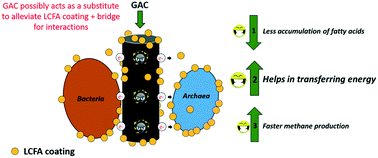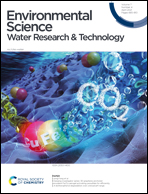Addition of granular activated carbon during anaerobic oleate degradation overcomes inhibition and promotes methanogenic activity†
Abstract
This study aimed to elucidate the mechanism of how GAC improves oleate degradation by comparing the degradation profile and microbial community changes from granular activated carbon (pellet GAC, rod shape, 0.8 × 3.0 mm) supplemented assays with various control assays, including non-conductive materials using silica beads and pumice stone. Addition of GAC showed on average an 164% decrease in lag-phase duration compared to no-GAC addition leading to quicker methane generation. In addition, when 2-bromoethanesulfonate was added to inhibit methanogens, LCFA degradation of oleate to palmitate, then further to acetate was 50% faster in GAC-amended conditions. Control assays showed no improvement in degradation profiles or methane generation. Changing the GAC particle sizes showed smaller particle sizes drastically shortening the lag-phase duration compared to larger particle sizes. Scanning electron microscopic imaging of GAC revealed promotion of biofilm growth with evidence of pili-like structures on its surface, while non-conductive materials did not. DNA microbial community analysis revealed similar relative abundance in the suspension for control assays and GAC-supplemented bottles with the dominant bacterial families Clostridiaceae (41 ± 6%) and Synergistaceae (30 ± 4%) and the archaea family Methanomicrobiaceae (61 ± 10%). On the other hand, the DNA microbial community from the GAC biofilm revealed a higher relative abundance of Geobacteraceae at 9%, compared to <2% from the inoculum and control assay suspensions, and Methanosaetaceae at 78%. Overall, this study revealed that the conductive property of GAC is likely the main driver for the improved AD process by promoting the growth of electroactive microorganisms and direct interspecies electron transfer process.



 Please wait while we load your content...
Please wait while we load your content...